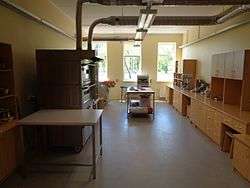Food technology
Food technology is a branch of food science that deals with the production processes that make foods.
Early scientific research into food technology concentrated on food preservation. Nicolas Appert’s development in 1810 of the canning process was a decisive event. The process wasn’t called canning then and Appert did not really know the principle on which his process worked, but canning has had a major impact on food preservation techniques.
Louis Pasteur's research on the spoilage of wine and his description of how to avoid spoilage in 1864 was an early attempt to apply scientific knowledge to food handling. Besides research into wine spoilage, Pasteur researched the production of alcohol, vinegar, wines and beer, and the souring of milk. He developed pasteurization—the process of heating milk and milk products to destroy food spoilage and disease-producing organisms. In his research into food technology, Pasteur became the pioneer into bacteriology and of modern preventive medicine.
Developments

Developments in food technology have contributed greatly to the food supply and have changed our world. Some of these developments are:
- Instantized Milk Powder - D.D. Peebles (U.S. patent 2,835,586) developed the first instant milk powder, which has become the basis for a variety of new products that are rehydratable. This process increases the surface area of the powdered product by partially rehydrating spray-dried milk powder.
- Freeze-drying - The first application of freeze drying was most likely in the pharmaceutical industry; however, a successful large-scale industrial application of the process was the development of continuous freeze drying of coffee.
- High-Temperature Short Time Processing - These processes, for the most part, are characterized by rapid heating and cooling, holding for a short time at a relatively high temperature and filling aseptically into sterile containers.
- Decaffeination of Coffee and Tea - Decaffeinated coffee and tea was first developed on a commercial basis in Europe around 1900. The process is described in U.S. patent 897,763. Green coffee beans are treated with water, heat and solvents to remove the caffeine from the beans.
- Process optimization - Food Technology now allows production of foods to be more efficient, Oil saving technologies are now available on different forms. Production methods and methodology have also become increasingly sophisticated.
Consumer acceptance
Historically, consumers paid little attention to food technologies. Nowadays, the food production chain is long and complicated and food technologies are diverse. Consequently consumers are uncertain about the determinants of food quality and find it difficult to understand them. Now, acceptance of food products very often depends on perceived benefits and risks associated with food. Popular views of food processing technologies matter. Especially innovative food processing technologies often are perceived as risky by consumers[1]
Acceptance of the different food technologies varies. While pasteurization is well recognized and accepted, high pressure treatment and even microwaves often are perceived as risky. Studies by the Hightech Europe project found that traditional technologies were well accepted in contrast to innovative technologies.[2]
Consumers form their attitude towards innovative food technologies through three main mechanisms: First, through knowledge or beliefs about risks and benefits correlated with the technology; second, through attitudes based on their own experience; and third, through application of higher order values and beliefs.[3] A number of scholars consider the risk-benefit trade-off as one of the main determinants of consumer acceptance,[4] although some researchers place more emphasis on the role of benefit perception (rather than risk) in consumer acceptance.[5]
Rogers (2010) defines five major criteria that explain differences in the acceptance of new technology by consumers: complexity, compatibility, relative advantage, trialability and observability.[6]
Acceptance of innovative technologies can be improved by providing non-emotional and concise information about these new technological processes methods. The HighTech project also suggests that written information has a higher impact on consumers than audio-visual information.[7]
Publications
- Food and Bioprocess Technology
- Lebensmittel-Wissenschaft & Technologie
See also
Notes and references
- Hans-Jürgen Bässler und Frank Lehmann : Containment Technology: Progress in the Pharmaceutical and Food Processing Industry. Springer, Berlin 2013, ISBN 978-3642392917
- Ueland Ö, G. H., Holm, F., Kalogeras, N., Leino, O., Luteijn, J., Magnusson, S.(2011). State of the art in benefit-risk analysis: Consumer perception. Food and Chemical Toxicology, 52(1)
- "Documents". Hightecheurope.eu. Archived from the original on 5 December 2012. Retrieved 1 February 2014.
- Olsen, N. V., Grunert, K.G., & Anne-Mette, S. (2010). Consumer acceptance of high-pressure processing and pulsed-electric field: a review. Trends in Food Science & Technology, 21(446-472)
- Frewer, Lynn J.; van der Lans, Ivo A.; Fischer, Arnout R.H.; Reinders, Machiel J.; Menozzi, Davide; Zhang, Xiaoyong; van den Berg, Isabelle; Zimmermann, Karin L. (April 2013). "Public perceptions of agri-food applications of genetic modification – A systematic review and meta-analysis". Trends in Food Science & Technology. 30 (2): 142–152. doi:10.1016/j.tifs.2013.01.003.
- Gaskell, George; Allum, Nick; Wagner, Wolfgang; Kronberger, Nicole; Torgersen, Helge; Hampel, Juergen; Bardes, Julie (February 2004). "GM Foods and the Misperception of Risk Perception" (PDF). Risk Analysis. 24 (1): 185–194. doi:10.1111/j.0272-4332.2004.00421.x. PMID 15028010.
- Rogers, Everett M. (2010). Diffusion of Innovations (5 ed.). New York: Free Press. ISBN 978-0743222099.
- "Documents". Hightecheurope.eu. Archived from the original on 5 December 2012. Retrieved 1 February 2014.
External links

